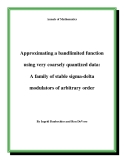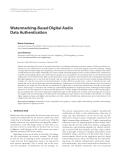
Digital signal digital data
-
Digital signal processing has revolutionized the storage and transmission of audio and video signals as well as still images, in consumer electronics and in more scientific settings (such as medical imaging). The main advantage of digital signal processing is its robustness: although all the operations have to be implemented with, of necessity, not quite ideal hardware, the a priori knowledge that all correct outcomes must lie in a very restricted set of well-separated numbers makes it possible to recover them by rounding off appropriately. ...
 33p
33p  tuanloccuoi
tuanloccuoi
 04-01-2013
04-01-2013
 50
50
 7
7
 Download
Download
-
EURASIP Journal on Applied Signal Processing 2003:10, 1001–1015 c 2003 Hindawi Publishing Corporation Watermarking-Based Digital Audio Data Authentication Martin Steinebach Fraunhofer Institute IPSI, MERIT, C4M Competence for Media Security, D-64293 Darmstadt, Germany Email: martin.steinebach@ipsi.fraunhofer.de Jana Dittmann Platanista GmbH and Otto-von-Guericke University Magdeburg, 39106 Magdeburg, Germany Email: jana.dittmann@iti.cs.uni-magdeburg.
 15p
15p  sting12
sting12
 10-03-2012
10-03-2012
 56
56
 4
4
 Download
Download












